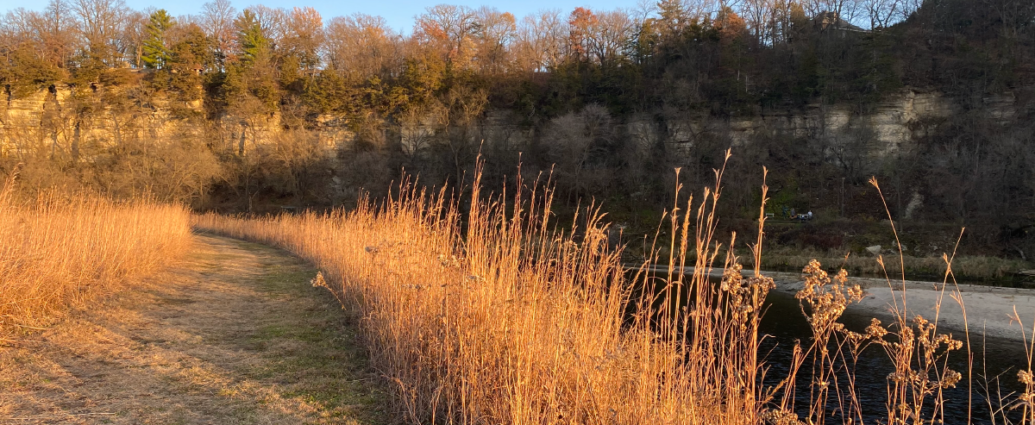Bird: Black-capped Chickadee (Poecile atricapillus)
Location: Anderson Prairie, Decorah, IA | Date: 10/04/2020
I am walking in Anderson Prairie on my birthday. My friend walks alongside me.
The tallgrass prairie is in the dip of its bloom, and we stand among the switchgrass, purple coneflowers, spiderwort, and a mosaic of other plants native to Iowa.
Grass trails are paved for us to pass through, but I cannot escape the thickness of it.
All that brushing, sweeping, tickling our ears, flushing our sight.
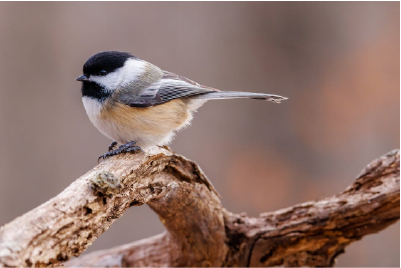 Today is the last birthday I’ll spend in Decorah. In a few months, I will be moving across the country. I’ll pack up my life and drive away, leaving behind the limestone outcroppings and parting rivers of the Driftless. A winter’s good-bye to three years untouched by glacier. A life lined by bluffs.
Today is the last birthday I’ll spend in Decorah. In a few months, I will be moving across the country. I’ll pack up my life and drive away, leaving behind the limestone outcroppings and parting rivers of the Driftless. A winter’s good-bye to three years untouched by glacier. A life lined by bluffs.
But today that does not matter, because it is my birthday, and I am here in the prairie. There are still tendrils of green sneaking through the starchy grasses, soon to shrivel under the November frost. Autumn sunlight hovers. And with those warm tallgrass hues. That leathery beige never looked so rich. I see a small bird flutter up from the tallgrasses and pause, resting lightly on the tip of a dried coneflower. I’ve never seen a rounder bird! A black head with white stripes on the sides, and a warm golden belly.
“Look at that bird! Look how cute!”
My friend who is walking with me, a researcher of birds, tells me that it is a black-capped chickadee. I am enamored.
That night, my friend gives me an old book of hers, a birthday gift. Field Guide to Birds of North America. It is worn and beautiful.
Bird: Red-bellied Woodpecker (Melanerpes carolinus)
Location: My backyard, Decorah, IA | Date: 11/02/2020
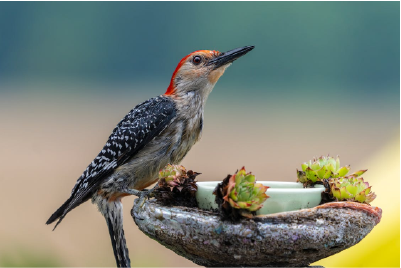 I can’t believe it’s November. One month closer to my grand departure.
I can’t believe it’s November. One month closer to my grand departure.
I am feeling sentimental, staring dully out the window to my backyard when a visitor stops by one of our oak trees. He ticks like a wind-up toy, mechanically drilling his beak. A zebra-striped back, with a cherry for a head. I run and grab my book, flipping through the pages, holding up different illustrations to the window until I find one that matches. A red-bellied woodpecker! I’ve identified my first bird! What a thrill!
I quickly grab a sticky note and mark in my book the date and location of where I saw my first red-bellied woodpecker. I slam it shut and press it against my chest, arms crossed overtop. I gaze lovingly at my new companion, watching as my home becomes his own. We share the moment. It feels so permanent.
Bird: Eastern Bluebird (Sialia sialis)
Location: Community Prairie, Decorah, IA | Date: 11/04/2020
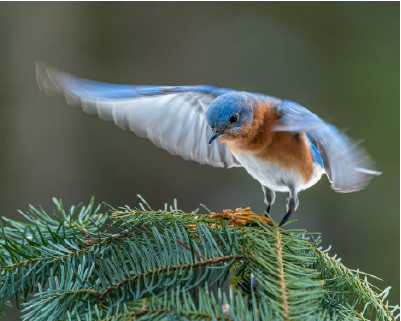 One grand tree stands alone. I sit under the tree with my friend on a strip of mowed land.
One grand tree stands alone. I sit under the tree with my friend on a strip of mowed land.
Woodland scapes beyond the Community Prairie are looking more bare and brown. The land is changing. Life is passing.
The grand tree is a snow globe. Inside is a flurry of motion. Birds, strange and unfamiliar, too many to remember. I wish I had brought my book with me.
“Look! That one!” I point out to my friend.
In the harsh sunlight we can barely make out the royal glint of its back. A rich velvet blue. It slices through crisp autumn breath to reveal a red breast and a white belly. I quickly close my eyes, furrowing madly, working to make the image stick.
When I open my eyes, a woman in blue has appeared. She looks small beneath her puffy cobalt coat. She introduces herself as a town biologist. We tell her that we are students. And so she treats us as such. She begins to teach. She tells us about the land and how it has changed. Local construction companies have eroded the topsoil, she tells us. There used to be so many more birds. And this used to be all tallgrass prairie. She tells us that her children used to play on the riverbanks of the Upper Iowa, which cuts through the prairie where we sit. Her children are grown now. When they come home, they don’t recognize the land.
She tells us that she is lonely.
And she then floats away, a fading vision of blue, and my friend and I are left to wonder if she was ever there at all. And I think about her grown children, and how sad they must feel to come home to a place they don’t remember. I wonder if I will recognize the land when I return someday. I wonder how things will change. Will all the birds be gone?
I think about my impending moving date. I wonder if I will be lonely, too.
Later, I learn from my book that the bird I saw was an eastern bluebird.
Bird: Downy Woodpecker (Picoides pubescens)
Location: My backyard, Decorah, IA | Date: 11/08/2020
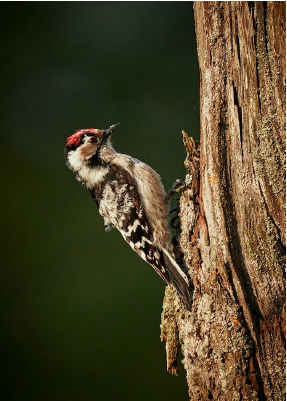 I call my mom and tell her that I’ve been birdwatching. I tell her about today’s find, spotted through my window. Dashing about our oaks.
I call my mom and tell her that I’ve been birdwatching. I tell her about today’s find, spotted through my window. Dashing about our oaks.
“A downy woodpecker!”
I know he is a male because of the strip of red on his head. Beneath the red his head is black with white stripes, smaller white dashes on a black tail. A white breast.
My mom tells me that she has also been wanting to learn about birdwatching. She says that birds are known to carry a lot of meanings, and that they appear to you for a reason. She is considering putting a bird feeder in her yard, so the birds will come and speak to her, deliver their special messages.
Birds with messages. I wonder what the downy woodpecker is trying to say to me. I imagine his little voice, Look at these winding oaks! Look at these rich prairies! Do you really want to leave so soon? And I can’t find the words to answer him.
Bird: Pileated Woodpecker (Dryocopus pileatus)
Location: My backyard, Decorah, IA | Date: 11/28/2020
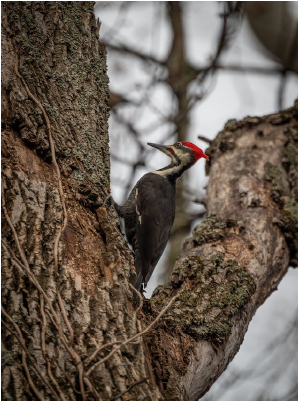 It is bizarre, magnificent, large (the largest woodpecker in North America since the Ivory-billed has gone extinct, according to my book). A blackish-brown back and belly. White stripes on a black head. A bursting red crown, feathers slicked back and fixed to a point: a grandiose headdress.
It is bizarre, magnificent, large (the largest woodpecker in North America since the Ivory-billed has gone extinct, according to my book). A blackish-brown back and belly. White stripes on a black head. A bursting red crown, feathers slicked back and fixed to a point: a grandiose headdress.
The pileated woodpecker.
I gasp when I see it through the window. I bow my head reverently and I wave regally as the woodpecker flocks to my precious terrain, my grand collection of oaks. It is a homecoming. It is a coronation.
It is past Thanksgiving. Winter is looming; I am getting antsier every day.
I think about what my mom said and I find myself google searching, What is the meaning of a pileated woodpecker? I find some poorly designed blog run by a woman in her mid-30’s. I feel that a person who finds time to craft a website devoted to such things probably has more expertise on the meanings of bird appearances than anyone I know. She tells me that pileated woodpeckers appear for many reasons, one being that a person needs to learn to follow the rhythm of their own life.
How can I follow the rhythm of my own life if it means leaving my kingdom behind? Who will watch the woodpeckers for me? Who will keep the land from changing?
Bird: Western Meadowlark (Sturnella neglecta)
Location: T.B.D. | Date: T.B.D.
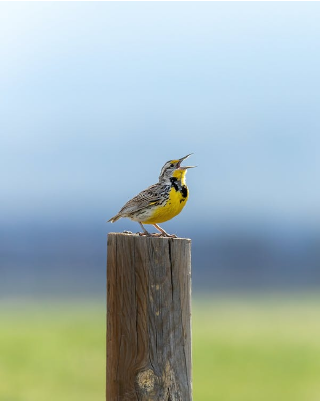 It is mid-December and I am walking through Anderson Prairie.
It is mid-December and I am walking through Anderson Prairie.
For years I’ve been tickled by the call of the meadowlark, but I have yet to see the poppy yellow of its belly, the crescent patch of black on its breast, looking so noble in my book’s illustration. I don’t have much time left to see a western meadowlark here, and so I’m hoping that today it’ll happen.
But it doesn’t. The prairie has shriveled. No snow yet, but the November frost has faded and sunk those last tendrils of green. Still dense with crispy stalks, but it all looks so frail. The wintry sun sets upon us, burning the edges of those dried coneflowers where chickadees once perched. I feel as though I’m intruding on a private moment. I leave the prairie to wither.
I walk back to my house, wondering if I’ll ever see the western meadowlark. I imagine it playing out perfectly: I follow its song to that grand tree in the prairie. The woman in blue is there, and my mom, and my friends, and the lady who writes a blog about the meaning of birds. And we all see that bursting yellow together. We kneel to that thin coal moon. And the blogger tells me what it means to see the western meadowlark. It means that you are ready to leave, she says. It means that there will be birds wherever you are after this.
And the grand tree wraps his branches around me, and he sends me off.
By Carson Schulte

